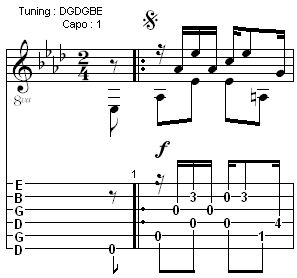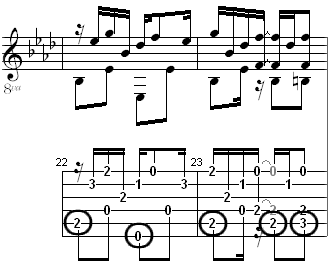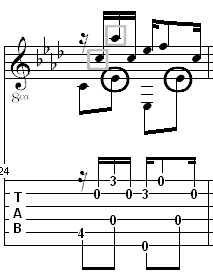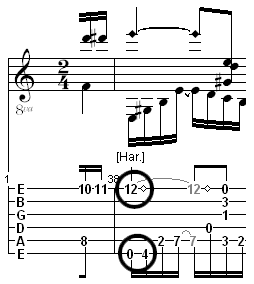Details : Guidelines... Not rules, but helps for my style & vision.
Some typical ones are explained here, however, they are not rules nor the best way to express Ragtime music on guitar. There should be various ways according to player's own view and character of his music. So, I simply wish these ones will help just for thinking over my own way, if someone would like to know... ;-)
Playing key
The original key should be kept in various ways.

This example indicates one of the typical ways to realize this guideline. As I just wrote in the previous page, here is realized the original A flat key, which is usually very difficult to play on guitar, using the Dropped G tuning with Capo on 1 fret. This tab software can display the staff notation in actual sound, so that we can compare easily the output of arrangement to the original piano score. Other examples are:
- B flat : Dropped G on Capo 3rd fret, or Normal on Capo 1st played by A key.
- D & G : Dropped D - Low A tone on open 5th string is useful for the G key, in fact.
- Other : Some original tunings applied - like "CGCGCE" for C. Please check them with "The List of Tabs."
Main & sub bass note
Main bass notes should be respected preferentially.

This piano example - "Maple Leaf" - shows how the (imaginary) bass line moved, especially in "Joplin-esque". As Dr. Edward Berlin indicates in the book "King of Ragtime", the writer of this great rag, Scott Joplin, must have paid much attention or a kind of passion to bass notes and their sequential movements.
So, I'd like to treat them carefully, and here I've done like below...

In this case it may be realized rather easily, because none of special difficulties might be laid in play - no stretch fingering form, no complicated movement, etc. Besides, it may be helped by another easiness in play - that is the bass tone in upbeat - Open string on the 4th.
Of course, very often we need the transportation of the note in the range of octave up and down, however, the tone will not be changed as far as possible.
Sub bass notes in upbeat have to be selected from the view of chordal harmony with other tones.

As you see the piano score above, the up beat of rag is usually organized in chord sound with 2 or 3 notes, while the number of guitar strings normally force us reducing or selecting 1 or 2 notes among them. So, which one should be selected? In my guideline it depends not only on play-ability but also on harmony. This example shows one better solution; up beat on open 4th string is easy to play and this E flat can help to make chordal harmony with other tones - C & A flat in melody. Additionaly saying, it will be natural in guitar play that these tones are sounded like an arpeggio, not staccato.
Of course there are lots of difficulties in this choice, but I'm going to pay attention always to the harmonic perspective. This guideline will be regarded more important, if we think about the number of string, which means a kind of limitation of the guitar sound. However, the limitation will be another joy on the road of eternal challenges.
Some techniques...
Harmonics are available to use, and my fun!

Harmonics must be one of the characteristic techniques in guitar play, and its beautiful sound always catch our ear. Moreover, it has some unique advantages below.
- Sustain: the tone is kept til natural decayed or forced mute.
- High tone: a disjuncted tone can be made on lower fret.
This left example shows one typical application of the former advantage, where I make a huge position change to play the unique bass line with keeping together the melody's top tone on high E. Despite we need a little interval to move our hand..., but isn't it a good idea, is it? Then the example of latter one will be found somewhere in my other arranges... ;-)

